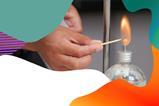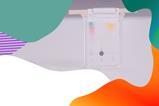Investigate the relative reactivity of metals in this video, including a demonstration and two experiments for learners
The reactions of the alkali metals in water, exothermic reactions of metals in acid and metal displacement reactions are featured in this video to provide learners with opportunities to explore the reactivity series of metals.
Chapter titles: 00:10 Introduction; 00:36 Alkalis metals and water experiment; 06:49 Metals and acid experiment; 10:35 Metal displacement reactions (microscale); 14:43 Summary.
Download additional resources
Supporting resources booklet including pause-and-think questions with answers, teacher notes, intended outcomes, follow-up worksheets and structure strips. Plus technician notes and integrated instructions. Editable versions of all worksheets and key documents are provided.
Teacher notes
Full teacher notes are available in the supporting resources booklet, including ideas for how to use this video and the supporting resources as part of your teaching.
Notes on running the practical experiments
The video offers three experiments that investigate the relative reactivity of metals. The first explores the reactions of the alkali metals in water and is a teacher demonstration. Exothermic reactions of metals and acid and metal displacement reactions are experiments that learners can carry out themselves. These investigations may be spread over two or three lessons to make the content manageable.
The displacement reactions are carried out in microscale using a spotting tile. This minimises the amount of chemicals used. Consider demonstrating the copper(II) sulfate reactions on a larger scale, so learners can clearly see a change in the colour of solution – it may be harder to spot in the dimple tray.
TIP You may need to remove the metal in the copper(II) sulfate solution to see that it has a brown layer of solid on it – it will look black when in the blue solution.
In the metal acid reactions observe the recommended concentration for the acid as there will not be a significant temperature rise at lower concentrations. Caution learners against using the thermometer to agitate the metal in the acid as there is a risk of making a hole in the cup as well as damaging the thermometer. This section of the video also looks at how to do a fair test.
Printable results tables are provided in the supporting resources booklet to save time in your practical lessons.
Extension work based on the reactivity of metals practical
To add additional higher level extension to this content, you could introduce an unknown metal and its metal salt and then ask the pupils to do an experiment to find out where it fits in the reactivity series, for example you could use tin and tin(II) sulfate. Learners could repeat the displacement reactions experiment and include the unknown metal and metal sulfate. Tin will be more reactive than copper but less reactive than iron.
Key terms
Learners will need to have a clear understanding of the following scientific terminology:
- reactivity
- displacement
- enthalpy
- exothermic
- acid
- alkali
- effervescence
- inert
- universal indicator
- group 1
Prior knowledge
Learners should be familiar with the periodic table of elements. They should know the definition of an element and be able to identify metals and non-metals using the periodic table.
Learners may have experience of investigating the relative reactivity of some metals at 11–14 using a simplified method, such as counting bubbles in a test tube.
Learners may know the products of a metal + acid reaction and be able to write a word equation. This is recapped in the video and the balanced symbol equations are introduced. Depending on where this topic falls in your learning sequence learners may not have practised balancing equations. It is unlikely that learners will have come across displacement prior to 14–16 study.
Redox reactions are introduced in this video, in terms of losing and gaining electrons, with the expectation that learners have covered this before. However, this could be used to develop understanding of redox reactions in further detail after finishing the practical work. Equally, you may take the decision to leave it out at this stage.
There are some questions included which ask learners to balance symbol equations. Depending on where the identification of ions comes in your scheme of work your learners may not have come across this yet. Adapt the questions to make them relevant to the stage and level that you are at. Some of the challenge tasks require learners to use and apply their knowledge from other topics.
Real-world contexts
- Learn about how a displacement reaction is used to keep trains on track.
- Explore the factors that affect the rate of rusting in the context of shipwrecks, including how nails over 400 years old survived on the seabed.
- Can iron and aluminium’s positions in the reactivity series make them contenders for fuels of the future?
- Find out about formulation chemists and how they need to understand the reactivity of raw ingredients.
Common misconceptions
Care should be taken when explaining why there is an increase in reactivity down group 1. This article explodes some myths about these reactions.
A common misconception held about chemical reactions is that reactants ‘disappear’. This may be exacerbated with observation of the metals with water or metals with acid. The alkali metals are observed to ‘disappear’ during the reaction with water. Reinforce that the alkali metal reactions produce soluble metal hydroxides using word and symbol equation to show that the alkali metals have not disappeared. It may be useful to add state symbols to show that the alkali metal reactants were solid whereas the metal hydroxides produced are in aqueous solution.
Learners may have a misconception that acid-metal reactions occur because the acid ‘eats away’ at the metal as this is their understanding of the term ‘corrosive’. Address the misconception by demonstrating that metals that are less reactive than hydrogen (copper, silver, gold, platinum) will not react with acid. Reinforce the process of neutralisation using word and symbol equations.
Magnesium may not produce as high a temperature change as zinc in the metal and acid reactions but it should be more reactive. This is because of the oxidised film on the outside of the Magnesium. Introduce the idea of metals being oxidised by showing oxidation of lithium, sodium and potassium and discussing everyday oxidation reactions that students will already be familiar with, eg rusting and tarnishing.
Diagnostic multiple-choice questions are a great way to explore students’ reasoning behind their answers. Best Evidence Science Teaching resources provide a great starting point to explore their ideas about reactivity of metals. Students are given a question and multiple plausible explanations for an observation. They then choose and justify which explanation they agree with. The resources available on the STEM Learning website include diagnostic questions on reactions in solutions, exothermic and endothermic reactions, neutralisation and periodic patterns – all of which would be useful starting points before learning about the reactivity of metals. Read more about diagnostic questioning.
Downloads
Reactivity series of metals: supporting resources
Handout | PDF, Size 0.36 mbReactivity series of metals: technician notes
Handout | PDF, Size 1.35 mbReactivity of metals: integrated instructions
Editable handout | PowerPoint, Size 0.35 mbReactivity series of metals: intended outcomes
Editable handout | Word, Size 0.11 mbReactivity series of metals: pause-and-think questions
Editable handout | Word, Size 0.14 mbReactivity series of metals: follow-up worksheets
Editable handout | Word, Size 0.53 mbReactivity series of metals: structure strips
Editable handout | Word, Size 0.13 mb
Additional information
Real-world contexts added by Ian McDaid.

Practical videos | 14–16 years

Videos of core practical experiments for flipped learning, remote teaching or revision
- 1
- 2
- 3
- 4
- 5
- 6
- 7
- 8
- 9
- 10
 Currently
reading
Currently
reading
Reactivity series of metals
- 12
- 13
- 14

















































1 Reader's comment